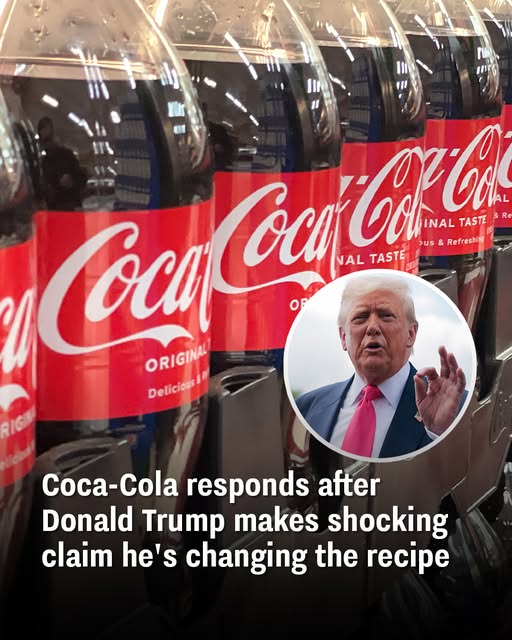THE SWEET POLITICS OF SODA: PRESIDENTIAL INTERVENTION, AGRICULTURAL POLICY, AND THE BATTLE FOR AMERICA’S BEVERAGE FUTURE
The intersection of presidential politics, agricultural policy, and consumer preferences has taken an unexpected turn with recent developments involving one of America’s most iconic beverages. The potential modification of a beloved soft drink recipe represents far more than a simple business decision—it illuminates complex relationships between government influence, agricultural subsidies, international trade, consumer health advocacy, and the powerful role of nostalgia in shaping American food culture.

The story of sweeteners in American beverages cannot be understood without examining the intricate web of agricultural policies, trade protections, and economic incentives that have shaped the nation’s food and beverage landscape for decades. The transition from cane sugar to high-fructose corn syrup in American soft drinks during the 1980s represented one of the most significant changes in food manufacturing history, driven by a combination of government subsidies, trade policies, and economic pressures that fundamentally altered the taste and composition of countless American food products.
The roots of this transformation trace back to agricultural policies implemented during the New Deal era and subsequently reinforced through decades of farm bills, trade agreements, and subsidy programs designed to support American agricultural production. These policies created powerful economic incentives that made corn-based sweeteners significantly cheaper than traditional cane sugar, leading to widespread adoption across the food and beverage industry despite concerns about taste differences and potential health implications.
The establishment of corn subsidies and sugar import restrictions created a protective economic environment that encouraged domestic corn production while making imported cane sugar prohibitively expensive for large-scale commercial use. This policy framework effectively guaranteed that American consumers would experience different versions of familiar products compared to consumers in other countries, where cane sugar remained the primary sweetener due to different economic and regulatory environments.
The political economy of sweetener policy involves complex relationships between agricultural interests, food manufacturers, labor unions, environmental groups, and consumer advocates, each with distinct priorities and concerns about the direction of American food policy. These stakeholder groups have historically wielded significant influence over policy decisions that affect everything from farm income to consumer prices to environmental sustainability.
The globalization of food markets has added additional complexity to sweetener policy, as American companies must navigate different regulatory environments, consumer preferences, and economic conditions in various international markets. This global perspective has created increasing awareness of the differences between American and international versions of familiar products, leading to growing consumer interest in alternatives that more closely resemble international formulations.
PRESIDENTIAL INFLUENCE ON CORPORATE DECISION-MAKING
The relationship between presidential authority and corporate decision-making represents a fascinating aspect of American political economy that extends far beyond formal regulatory powers to encompass informal influence, public pressure, and the strategic use of presidential platforms to shape business behavior. While presidents lack direct authority to mandate changes in private sector product formulations, they possess considerable soft power through their ability to influence public opinion, regulatory priorities, and political environments that affect corporate operations.
Presidential interventions in corporate affairs have historical precedents ranging from antitrust enforcement to trade policy modifications, but direct involvement in product formulation decisions represents a relatively unusual application of presidential influence. Such interventions typically reflect broader political strategies related to agricultural policy, consumer advocacy, or efforts to demonstrate responsiveness to public concerns about food quality and health.
The effectiveness of presidential influence on corporate decision-making depends on various factors including the political environment, public support for proposed changes, economic implications for affected companies, and the alignment of presidential priorities with existing corporate strategies. Companies must carefully balance presidential preferences with their own business interests, shareholder expectations, and market conditions when responding to such interventions.
The public nature of presidential communications about corporate policies creates additional pressures and considerations for companies, as they must manage not only the immediate request but also the broader public relations implications of their response. Social media platforms and modern communications technologies have amplified the reach and impact of presidential statements about corporate behavior, creating new dynamics in these relationships.
The precedent-setting nature of presidential corporate interventions can have implications beyond the immediate case, as other companies and industries may anticipate similar pressure or attention from the administration. This dynamic can influence corporate strategic planning and decision-making processes as companies consider potential political risks and opportunities in their business operations.
THE SCIENCE AND ECONOMICS OF SWEETENER CHOICE
The technical differences between various sweetening agents extend far beyond simple taste preferences to encompass complex considerations related to food chemistry, manufacturing processes, cost structures, and nutritional implications. High-fructose corn syrup and cane sugar, while both providing sweetness, have distinct chemical compositions, processing requirements, and functional properties that affect product taste, texture, shelf life, and manufacturing costs.
From a food science perspective, the choice of sweetener affects not only taste but also the physical properties of beverages, including viscosity, color, carbonation retention, and flavor interactions with other ingredients. These technical considerations can significantly impact product quality, consumer acceptance, and manufacturing efficiency, making sweetener selection a complex decision that involves multiple engineering and quality control factors.
The economic implications of sweetener choice extend throughout the supply chain, from agricultural production to manufacturing to retail distribution. The cost differential between different sweeteners can represent millions of dollars in annual expenses for large beverage companies, making any change in sweetener policy a significant financial decision that requires careful analysis of market conditions, supply chain reliability, and long-term cost projections.
Supply chain considerations for different sweeteners involve distinct agricultural regions, processing facilities, transportation networks, and storage requirements that can affect product availability, cost stability, and quality consistency. The infrastructure investments required to support different sweetener systems can represent substantial capital commitments that influence corporate strategic planning and operational flexibility.
The nutritional and health implications of different sweeteners continue to be subjects of scientific research and public health debate, with ongoing studies examining metabolic effects, consumption patterns, and potential links to various health conditions. These health considerations increasingly influence consumer preferences and regulatory discussions about food and beverage formulations.
AGRICULTURAL POLICY AND DOMESTIC PRODUCTION
The potential shift toward domestic cane sugar production represents a significant development in American agricultural policy that could have far-reaching implications for farming communities, land use patterns, environmental sustainability, and rural economic development. The expansion of sugar cane cultivation in the United States would require substantial investments in agricultural infrastructure, processing facilities, and supply chain networks that could reshape regional economies and agricultural landscapes.
Currently, American sugar cane production is concentrated in specific geographic regions with appropriate climate conditions, primarily in Florida, Louisiana, Hawaii, and Texas. Expanding this production to meet the demands of the soft drink industry would require either intensification of existing operations or expansion into new geographic areas, each approach carrying distinct economic, environmental, and social implications.
The environmental considerations associated with expanded sugar cane production include water usage, soil impacts, pesticide applications, and effects on local ecosystems and wildlife habitats. These environmental factors are increasingly important in agricultural policy discussions and corporate sustainability commitments, particularly as climate change and environmental protection become more prominent public concerns.
The economic impact of expanded domestic sugar production would extend beyond agricultural communities to include processing facilities, transportation networks, and related service industries. These economic effects could provide significant benefits to rural communities while also creating new infrastructure demands and potential environmental challenges.
The international trade implications of increased domestic sugar production could affect relationships with traditional sugar-exporting countries and may require modifications to existing trade agreements and import policies. These international dimensions add complexity to domestic agricultural policy decisions and require careful consideration of diplomatic and economic relationships.
CONSUMER PREFERENCES AND MARKET DYNAMICS
The potential change in sweetener formulation reflects broader shifts in consumer preferences toward perceived naturalness, authenticity, and quality in food and beverage products. These preferences have been influenced by increasing awareness of ingredient differences, health considerations, and exposure to international versions of familiar products that use different formulations.
Market research consistently demonstrates consumer interest in products with simpler ingredient lists, recognizable components, and formulations that more closely resemble traditional or international versions. This trend has driven significant innovation in the food and beverage industry as companies seek to balance consumer preferences with cost considerations and technical requirements.
The premium pricing potential for products using cane sugar reflects consumer willingness to pay higher prices for perceived quality improvements, creating market opportunities for companies that can successfully position reformulated products as superior alternatives to existing offerings. This pricing dynamic could help offset some of the increased costs associated with using more expensive sweeteners.
The regional variations in consumer preferences for sweetener types reflect cultural differences, taste preferences, and varying levels of awareness about ingredient differences. These regional patterns could influence how companies approach product reformulation and marketing strategies for different geographic markets.
The generational aspects of sweetener preferences show distinct patterns, with younger consumers often expressing stronger preferences for natural ingredients and showing greater willingness to pay premium prices for products that meet their ingredient criteria. Understanding these generational differences is crucial for companies planning long-term product strategies.
INTERNATIONAL COMPARISONS AND GLOBAL MARKETS
The existence of different formulations for the same products in different countries highlights the complex interplay between local economic conditions, regulatory environments, and consumer preferences that shape global food and beverage markets. These international variations provide natural experiments for understanding the effects of different sweetener choices on consumer acceptance, market performance, and brand perception.
Mexican Coca-Cola, which uses cane sugar and has developed a cult following among American consumers, represents a fascinating case study in how ingredient differences can create distinct market segments and consumer preferences. The premium pricing and specialty distribution of Mexican Coca-Cola in the United States demonstrates consumer willingness to pay higher prices for preferred formulations.
The European Union’s different approach to sweetener regulation and agricultural policy has resulted in product formulations that often differ significantly from American versions, providing additional examples of how policy environments shape product characteristics. These differences have implications for international trade, consumer expectations, and corporate strategic planning.
The Australian and other international markets that use cane sugar in soft drinks provide additional reference points for understanding the taste, cost, and market implications of different sweetener choices. These international examples can inform discussions about potential changes to American formulations and help predict consumer responses.
The global nature of major beverage companies creates complexities in managing different formulations across various markets while maintaining brand consistency and operational efficiency. These operational challenges must be balanced against local market preferences and regulatory requirements.
HEALTH CONSIDERATIONS AND PUBLIC POLICY
The ongoing debate about the health implications of different sweeteners reflects broader concerns about diet-related health issues, obesity rates, and the role of processed foods in American nutrition patterns. While both cane sugar and high-fructose corn syrup are forms of added sugar with similar caloric content, some research suggests potential differences in metabolic effects and health outcomes.
The scientific literature on sweetener health effects continues to evolve, with ongoing research examining questions about metabolism, satiety, taste preferences, and potential links to various health conditions. These research findings influence public health recommendations, regulatory policies, and consumer preferences in complex ways.
Public health organizations have generally focused on reducing overall sugar consumption rather than advocating for specific types of sweeteners, emphasizing the importance of moderation and balanced nutrition regardless of sweetener source. This approach reflects the scientific consensus that excessive consumption of any added sugar can contribute to health problems.
The regulatory environment for sweeteners involves multiple agencies and complex approval processes that evaluate safety, manufacturing standards, and labeling requirements. These regulatory frameworks must balance consumer protection with innovation and market flexibility.
The intersection of sweetener policy with broader public health initiatives, including obesity prevention, diabetes management, and nutritional education, creates additional considerations for policy makers and public health advocates working on diet-related health issues.
ECONOMIC IMPLICATIONS FOR INDUSTRY AND CONSUMERS
The potential shift to cane sugar in American soft drinks would have significant economic implications throughout the beverage industry, from manufacturing costs to retail pricing to competitive dynamics among different brands and product categories. These economic effects would ultimately influence consumer choices, market competition, and industry structure.
The cost implications of using cane sugar instead of high-fructose corn syrup could result in higher retail prices for affected products, potentially affecting consumer purchasing patterns and market demand. The magnitude of these price effects would depend on various factors including the scale of reformulation, supply chain efficiency, and competitive responses from other companies.
The impact on corn farmers and related agricultural sectors could be substantial if major beverage companies reduced their use of corn-based sweeteners, potentially affecting rural economies and agricultural communities that have benefited from corn subsidy programs. These economic transitions would require careful management to minimize negative impacts on affected communities.
The competitive implications of sweetener changes could affect market dynamics among different beverage companies, particularly if some companies adopt cane sugar while others maintain existing formulations. These competitive effects could influence market share, pricing strategies, and product positioning across the industry.
The supply chain investments required to support increased cane sugar usage could represent significant capital commitments for beverage companies, potentially affecting their financial performance and strategic planning. These investments would need to be balanced against expected returns and market opportunities.
TECHNOLOGICAL AND MANUFACTURING CONSIDERATIONS
The technical challenges associated with reformulating major beverage products extend beyond simple ingredient substitution to encompass complex considerations related to taste consistency, quality control, manufacturing efficiency, and product stability. These technical factors significantly influence the feasibility and timeline of potential reformulation efforts.
The manufacturing equipment and processes optimized for high-fructose corn syrup may require modifications or replacements to accommodate cane sugar, potentially requiring substantial capital investments and operational changes. These technical requirements could affect the speed and cost of any reformulation efforts.
Quality control procedures for different sweeteners involve distinct testing protocols, specification requirements, and monitoring systems that must be integrated into existing manufacturing operations. These quality assurance considerations are crucial for maintaining product consistency and consumer satisfaction.
The shelf life and stability characteristics of products using different sweeteners may vary, potentially affecting distribution strategies, inventory management, and retail operations. These logistical considerations must be carefully evaluated as part of any reformulation planning.
The flavor optimization process for reformulated products involves extensive testing and refinement to achieve taste profiles that meet consumer expectations while maintaining the distinctive characteristics that define brand identity. This optimization process can be time-consuming and require significant research and development investments.
ENVIRONMENTAL AND SUSTAINABILITY IMPLICATIONS
The environmental implications of expanded sugar cane production involve complex considerations related to land use, water resources, chemical inputs, and ecosystem impacts that must be balanced against sustainability goals and environmental protection requirements. These environmental factors are increasingly important in corporate decision-making and public policy discussions.
Water usage requirements for sugar cane cultivation can be substantial, particularly in regions with limited water resources or competing demands for agricultural water. The sustainability of expanded sugar cane production depends on efficient water management practices and consideration of regional water availability.
The carbon footprint implications of different sweetener choices involve complex calculations related to agricultural production, processing energy requirements, transportation distances, and packaging considerations. These climate impact assessments are becoming more important in corporate sustainability planning and consumer purchasing decisions.
Soil health and agricultural sustainability practices in sugar cane production affect long-term environmental outcomes and the viability of expanded production. Sustainable farming practices can help minimize environmental impacts while maintaining productive agricultural operations.
The biodiversity implications of expanded sugar cane cultivation must be considered in planning agricultural expansion, particularly in regions with sensitive ecosystems or endangered species habitats. These conservation considerations may influence where and how sugar cane production can be expanded.
POLITICAL ECONOMY AND POLICY IMPLICATIONS
The political dynamics surrounding sweetener policy reflect broader debates about the role of government in agricultural markets, trade policy, consumer protection, and economic regulation. These political considerations influence policy decisions and create various incentives and constraints for different stakeholder groups.
The lobbying activities and political influence of various agricultural interests, including corn farmers, sugar producers, and food manufacturers, create complex political dynamics that affect policy decisions about sweetener regulation and trade policy. Understanding these political relationships is crucial for predicting policy outcomes and industry developments.
The trade policy implications of sweetener decisions involve international relationships, trade agreements, and economic diplomacy that extend beyond domestic considerations to encompass global economic relationships. These international dimensions add complexity to policy decisions and require careful consideration of diplomatic consequences.
The regulatory framework for sweetener policy involves multiple agencies, complex approval processes, and various enforcement mechanisms that must be coordinated to ensure effective policy implementation. These regulatory challenges require ongoing attention and resources to maintain effective oversight.
The precedent-setting nature of presidential intervention in corporate product decisions could influence future relationships between government and industry, potentially affecting business planning and political risk assessments across various sectors.
FUTURE TRENDS AND IMPLICATIONS
The potential changes in sweetener policy reflect broader trends in food and beverage markets toward natural ingredients, transparent labeling, and consumer-driven product development. These trends are likely to continue influencing industry practices and regulatory policies in the coming years.
The technological developments in sweetener production, including advances in agricultural techniques, processing methods, and alternative sweetener development, could provide new options for addressing consumer preferences while managing cost and sustainability considerations.
The evolving consumer preferences for health-conscious products, environmental sustainability, and authentic ingredients are likely to continue driving demand for product reformulations and creating market opportunities for companies that can successfully respond to these preferences.
The international trade implications of sweetener policy changes could affect global agricultural markets, trade relationships, and economic development in various countries that participate in sugar and corn markets.
The long-term sustainability of different sweetener systems depends on ongoing developments in agricultural technology, environmental management, and climate adaptation strategies that will influence the viability of various production systems.
CONCLUSION: SWEET COMPLEXITY IN AMERICAN FOOD POLICY
The potential modification of America’s most iconic soft drink represents far more than a simple recipe change—it embodies the complex interplay of political influence, agricultural policy, consumer preferences, and economic considerations that shape American food culture. The discussions surrounding sweetener choice illuminate fundamental questions about the role of government in influencing corporate decisions, the balance between market forces and policy intervention, and the ongoing evolution of American consumer preferences.
The technical, economic, and political complexities involved in sweetener policy demonstrate how seemingly simple product decisions can have far-reaching implications for agricultural communities, manufacturing operations, consumer costs, and environmental sustainability. These multifaceted considerations require careful analysis and stakeholder engagement to ensure that policy decisions serve both economic efficiency and public interest.
The precedent of presidential intervention in corporate product decisions raises important questions about the appropriate scope of government influence in private sector operations and the potential implications for future relationships between political leaders and business organizations. These questions will likely continue to influence discussions about the proper boundaries of political and economic power in American society.
The consumer response to potential sweetener changes will ultimately determine the success of any reformulation efforts and provide valuable insights into American preferences regarding naturalness, authenticity, and quality in food and beverage products. These market responses will help inform future decisions about product development and regulatory policy.
The international dimensions of sweetener policy highlight the global nature of modern food markets and the importance of considering international competitiveness, trade relationships, and diplomatic implications in domestic policy decisions. These global considerations add complexity to policy planning and require sophisticated understanding of international economic relationships.
Moving forward, the evolution of sweetener policy will likely continue to reflect broader trends in American food culture, environmental awareness, and consumer advocacy that are reshaping expectations for food and beverage products. Understanding these trends and their implications will be crucial for businesses, policymakers, and consumers navigating the future of American food policy.
The ultimate outcome of current discussions about sweetener policy will depend on the successful balance of competing interests, technical feasibility, economic considerations, and consumer acceptance. This balance requires ongoing dialogue among stakeholders and careful attention to the complex factors that influence food policy decisions in democratic societies.




